-

新人教版高中英语选修2Unit 1 Science and Scientists-Learning about Language教学设计
Step 7: complete the discourse according to the grammar rules.Cholera used to be one of the most 1.__________ (fear) diseases in the world. In the early 19th century, _2_________ an outbreak of cholera hit Europe, millions of people died. But neither its cause, 3__________ its cure was understood. A British doctor, John Snow, wanted to solve the problem and he knew that cholera would not be controlled _4_________ its cause was found. In general, there were two contradictory theories 5 __________ explained how cholera spread. The first suggested that bad air caused the disease. The second was that cholera was caused by an _6_________(infect) from germs in food or water. John Snow thought that the second theory was correct but he needed proof. So when another outbreak of cholera hit London in 1854, he began to investigate. Later, with all the evidence he _7_________ (gather), John Snow was able to announce that the pump water carried cholera germs. Therefore, he had the handle of the pump _8_________ (remove) so that it couldn't be used. Through his intervention,the disease was stopped in its tracks. What is more, John Snow found that some companies sold water from the River Thames that __9__________________ (pollute) by raw waste. The people who drank this water were much more likely _10_________ (get) cholera than those who drank pure or boiled water. Through John Snow's efforts, the _11_________ (threaten) of cholera around the world saw a substantial increase. Keys: 1.feared 2.when 3. nor 4.unless 5.that/which 6.infection 7.had gathered 8.removed 9.was polluted 10.to get 11. threat

新人教版高中英语选修2Unit 1 Science and Scientists-Reading and thinking教学设计
Step 5: After learning the text, discuss with your peers about the following questions:1.John Snow believed Idea 2 was right. How did he finally prove it?2. Do you think John Snow would have solved this problem without the map?3. Cholera is a 19th century disease. What disease do you think is similar to cholera today?SARS and Covid-19 because they are both deadly and fatally infectious, have an unknown cause and need serious public health care to solve them urgently.keys:1. John Snow finally proved his idea because he found an outbreak that was clearly related to cholera, collected information and was able to tie cases outside the area to the polluted water.2. No. The map helped John Snow organize his ideas. He was able to identify those households that had had many deaths and check their water-drinking habits. He identified those houses that had had no deaths and surveyed their drinking habits. The evidence clearly pointed to the polluted water being the cause.3. SARS and Covid-19 because they are both deadly and fatally infectious, have an unknown cause and need serious public health care to solve them urgently.Step 6: Consolidate what you have learned by filling in the blanks:John Snow was a well-known _1___ in London in the _2__ century. He wanted to find the _3_____ of cholera in order to help people ___4_____ it. In 1854 when a cholera __5__ London, he began to gather information. He ___6__ on a map ___7___ all the dead people had lived and he found that many people who had ___8____ (drink) the dirty water from the __9____ died. So he decided that the polluted water ___10____ cholera. He suggested that the ___11__ of all water supplies should be _12______ and new methods of dealing with ____13___ water be found. Finally, “King Cholera” was __14_____.Keys: 1. doctor 2. 19th 3.cause 4.infected with 5.hit 6.marked 7.where 8.drunk 9.pump 10.carried 11.source 12.examined 13.polluted 14.defeatedHomework: Retell the text after class and preview its language points

新人教版高中英语选修2Unit 1 Science and Scientists-Using langauge教学设计
This happens because the dish soap molecules have a strong negative charge, and the milk molecules have a strong positive charge. Like magnets, these molecules are attracted to each other, and so they appear to move around on the plate, taking the food coloring with them, making it look like the colors are quickly moving to escape from the soap.Listening text:? Judy: Oh, I'm so sorry that you were ill and couldn't come with us on our field trip. How are you feeling now? Better?? Bill: Much better, thanks. But how was it?? Judy: Wonderful! I especially liked an area of the museum called Light Games.it was really cool. They had a hall of mirrors where I could see myself reflected thousands of times!? Bill: A hall of mirrors can be a lot of fun. What else did they have?? Judy: Well, they had an experiment where we looked at a blue screen for a while, and then suddenly we could see tiny bright lights moving around on it. You'll never guess what those bright lights were!? Bill: Come on, tell me!? Judy: They were our own blood cells. For some reason, our eyes play tricks on us when we look at a blue screen, and we can see our own blood cells moving around like little lights! But there was another thing I liked better. I stood in front of a white light, and it cast different shadows of me in every color of the rainbow!? Bill: Oh, I wish I had been there. Tell me more!? Judy: Well, they had another area for sound. They had a giant piano keyboard that you could use your feet to play. But then, instead of playing the sounds of a piano, it played the voices of classical singers! Then they had a giant dish, and when you spoke into it, it reflected the sound back and made it louder. You could use it to speak in a whisper to someone 17 meters away.? Bill: It all sounds so cool. I wish I could have gone with you? Judy: I know, but we can go together this weekend. I'd love to go there again!? Bill: That sounds like a great idea!

新人教版高中英语选修2Unit 2 Bridging Cultures-Discovering useful structures教学设计
The grammar of this unit is designed to review noun clauses. Sentences that use nouns in a sentence are called noun clauses. Nominal clauses can act as subject, object, predicate, appositive and other components in compound sentences. According to the above-mentioned different grammatical functions, nominal clauses are divided into subject clause, object clause, predicate clause and appositive clause. In this unit, we will review the three kinds of nominal clauses. Appositive clauses are not required to be mastered in the optional compulsory stage, so they are not involved.1. Guide the students to judge the compound sentences and determine the composition of the clauses in the sentence.2. Instruct students to try to learn grammar by generalizing grammar rules, controlling written practice, and semi-open oral output.3. Inspire the students to systematize the function and usage of noun clause1.Instruct students to try to learn grammar by generalizing grammar rules, controlling written practice, and semi-open oral output.2.Inspire the students to systematize the function and usage of noun clauseStep1: The teacher ask studetns to find out more nominal clauses from the reading passage and udnerline the nominal clauses.

新人教版高中英语选修2Unit 3 Food and Culture-Reading and thinking教学设计
The discourse explores the link between food and culture from a foreign’s perspective and it records some authentic Chinese food and illustrates the cultural meaning, gerography features and historic tradition that the food reflects. It is aimed to lead students to understand and think about the connection between food and culture. While teaching, the teacher should instruct students to find out the writing order and the writer’s experieces and feelings towards Chinese food and culture.1.Guide the students to read the text, sort out the information and dig out the topic.2.Understand the cultural connotation, regional characteristics and historical tradition of Chinese cuisine3.Understand and explore the relationship between food and people's personality4.Guide the students to use the cohesive words in the text5.Lead students to accurately grasp the real meaning of the information and improve the overall understanding ability by understanding the implied meaning behind the text.1. Enable the Ss to understand the structure and the writing style of the passage well.2. Lead the Ss to understand and think further about the connection between food and geography and local character traits.Step1: Prediction before reading. Before you read, look at the title, and the picture. What do you think this article is about?keys:It is about various culture and cuisine about a place or some countries.

新人教版高中英语选修2Unit 5 First Aid-Discovering useful structures教学设计
You have no excuse for not going.你没有理由不去。He was punished for not having finished his homework.他因未完成作业而受到惩罚。2.动词ing形式复合结构由物主代词或人称代词宾格、名词所有格或普通格加动词ing,即“sb./sb.'s+doing”构成。动词ing形式的复合结构实际上是给动词ing形式加了一个逻辑主语。动词ing形式的复合结构有四种形式:①形容词性物主代词+动词ing②名词所有格+动词ing③代词宾格+动词ing④名词+动词ingHer coming to help encouraged all of us.她来帮忙鼓舞了我们所有人。The baby was made awake by the door suddenly shutting.这个婴儿被突然的关门声吵醒了。Can you imagine him/Jack cooking at home?你能想象他/杰克在家做饭的样子吗?无生命名词无论是作主语还是作宾语都不能用第②种形式。Tom's winning first prize last year impressed me a lot.汤姆去年得了一等奖使我印象深刻。Do you mind my/me/Jack's/Jack leaving now?你介意我/杰克现在离开吗?Excuse me for my not coming on time.很抱歉我没能按时来。His father's being ill made him worried.他父亲病了,他很担心。We are looking forward to the singer's/the singer to give us a concert.我们盼望着这位歌手来给我们举办一场演唱会。

新人教版高中英语必修3Unit 1 Festivals and Celebrations-Reading and Thinking教学设计
The topic of this part is “Discover the reasons for festivals and celebrations.The Listening & Speaking & Talking part aims at talking about the experiences and feelings or emotions about the festivals and celebrations. This section aims at detecting the reason why the people celebrate the festivals, the time, the places, the types and the way of celebrations. It also explains why some traditions in the old celebrations are disappearing, like the firecrackers in the big cities and some new things are appearing like the prosperity of business or commerce. 1. Students can talk about what festivals they know and the reasons and the way of celebrating them.2. Students should learn the reading skills such as the headline and get the topic sentences, the structures of articles.3. Students can understand the past, the present situation of some festival around the world and why there are some changes about them. 4. Students can have the international awareness about the festivals.1. Students should learn the reading skills such as the headline and get the topic sentences, the structures of articles.2. Students can understand the past, the present situation of some festival around the world and why there are some changes about them.Step 1 Lead in---Small talkWhat festival do you like best ? Why ?I like the Spring Festivals because I can set off the fireworks, receive the lucky money and enjoy the Gala with my families.Step 2 Before reading---Pair workWhy do people celebrate different festivals ?The Spring Festivals is to celebrate the end of winter and the coming of spring and new life.The Mid-autumn Day is to celebrate the harvest and admire the moon.

新人教版高中英语必修3Unit 3 Diverse Cultures-Reading for Writing教学设计
The topic of this part is “Describe a place with distinctive cultural identity”.This section focuses on Chinese culture by introducing Chinatown, whose purpose is to show the relationship between the Chinese culture and American culture. The Chinese culture in Chinatown is an important part of American culture. Chinatown is an important window of spreading Chinese culture and the spirit homeland of oversea Chinese, where foreigners can experience Chinese culture by themselves.Concretely, the title is “Welcome to Chinatown!”, from which we can know that the article aims at introducing Chinatown. The author used the “Introduction--Body Paragraph--Conclusion” to describe the people, language, architecture, business, famous food and drinks and people’s activities, which can be a centre for Chinese culture and shows its unique charm.1. Read quickly to get main idea; read carefully to get the detailed information.2. Learn the characteristics of writing and language.3. Learn to introduce your own town according to the text.4. Learn to correct others’ writing.1. Learn the characteristics of writing and language.2. Learn to introduce your own town according to the text.Step 1 Lead in ---Small talkIn the reading part, we mentioned the Chinatown of San Francisco. How much do you know about Chinatown of San Francisco ?Chinatown is a main living place for Chinese immigrants, where you can see many Chinese-style buildings, costumes, operas, restaurants, music and even hear Chinese.Step 2 Before reading ---Predict the contentWhat is the writer’s purpose of writing this text ? How do you know ?From the title(Welcome to Chinatown) and some key words from the text(tourist, visit, visitors, experience), we can know the purpose of the text is to introduce Chinatown and show the relationship between Chinese culture and American culture.

新人教版高中英语必修3Unit 5 The Value of Money- Discovering Useful Structure教学设计
Step 3 Meaning1. 过去将来时表示从过去某一时间来看将要发生的动作或存在的状态, 常用在宾语从句中。一般由“would/should +动词原形”构成。She hoped that they would meet again someday. 她希望将来有一天他们能再见面。2. was/were going to+动词原形: 表示过去将要发生或很有可能发生的动作, 常用于口语中, 表示预言、意图或者打算等。He was going to start work the following week. 他打算下星期开始工作。3. was/were about to do: 常用来表示即将发生的动作, “刚要/正要做……”。注意该结构不与任何时间状语连用。I felt that something terrible was about to happen. 我感到某种可怕的事情即将发生。4.was/were to do: 表示“曾计划做某事”, 如果表示“本来计划做某事, 动作没实现”, 则需用 “was/were to have done”。She said she was to have told me about the accident. 她说她本来想告诉我关于事故的事。5.Start, go, come, leave, see, meet等动词的过去进行时: 表示就过去某一时刻而言即将发生的动作。She was coming later. 她随后就来。I had just put on my overcoat and was leaving to visit a friend of mine. 我刚穿上外套要去看我的一个朋友。

新人教版高中英语选修2Unit 3 Food and Culture-Discovering useful structures教学设计
The newspaper reported more than 100 people had been killed in the thunderstorm.报纸报道说有一百多人在暴风雨中丧生。(2)before、when、by the time、until、after、once等引导的时间状语从句的谓语是一般过去时,以及by、before后面接过去的时间时,主句动作发生在从句的动作或过去的时间之前且表示被动时,要用过去完成时的被动语态。By the time my brother was 10, he had been sent to Italy.我弟弟10岁前就已经被送到意大利了。Tons of rice had been produced by the end of last month. 到上月底已生产了好几吨大米。(3) It was the first/second/last ... time that ...句中that引导的定语从句中,主语与谓语构成被动关系时,要用过去完成时的被动语态。It was the first time that I had seen the night fact to face in one and a half years. 这是我一年半以来第一次亲眼目睹夜晚的景色。(4)在虚拟语气中,条件句表示与过去事实相反,且主语与谓语构成被动关系时,要用过去完成时的被动语态。If I had been instructed by him earlier, I would have finished the task.如果我早一点得到他的指示,我早就完成这项任务了。If I had hurried, I wouldn't have missed the train.如果我快点的话,我就不会误了火车。If you had been at the party, you would have met him. 如果你去了晚会,你就会见到他的。
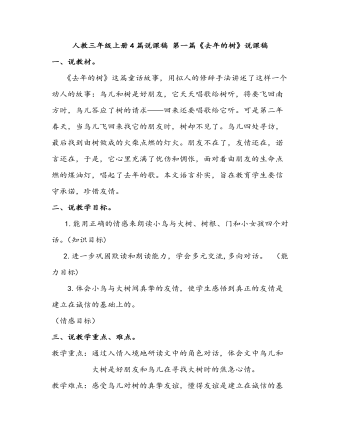
人教版三年级上册语文说课稿
二、说教学目标。 1.能用正确的情感来朗读小鸟与大树、树根、门和小女孩四个对话。(知识目标) 2.进一步巩固默读和朗读能力,学会多元交流,多向对话。 (能力目标) 3.体会小鸟与大树间真挚的友情,使学生感悟到真正的友情是建立在诚信的基础上的。

人教版新课标小学数学一年级上册几和几 说课稿
(一)教学内容:教科书数学一年级上册第19-20的内容及练习二的第8-10题。(二)教材所处地位及作用:“几和几”数的组成知识是学习加减法的基础,这是一年级教学要注意的部分。在认数教学中,主要通过实物演示和动手操作的游戏,使学生知道了数的组成。(三)教学目标、重点、难点:教学目标:(1)使学生通过动手操作掌握5以内数的组成。(2)使学生能熟练地说出5以内数的级成,培养学生的观察、操作、表达能力,初步的自学能力。(3)培养学生认真做练习的良好习惯,积极动脑思考的学习品质及互助,创新意识和评价意识。教学重点:让学生通过动手操作掌握5以内数的组成教学难点:引导学生通过动手操作并掌握5以内数的组成。二、说教法本课时教学方法主要体现以下几点:1、创设游戏充分感知,然后再交流,使学生在主动参与知识的形成过程中体验到成功的快乐。最后,为学生创设了“分小棒”等游戏,让学生不断地动手操作与合作讨论中自己掌握知识,并初步培养学生的自学能力。
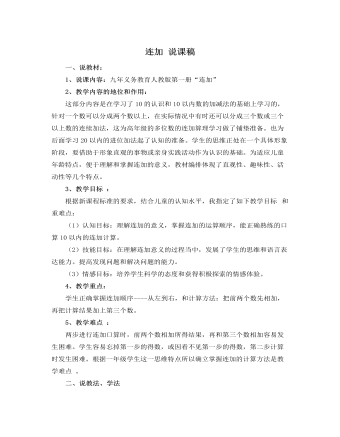
人教版新课标小学数学一年级上册连加 说课稿
[设计意图:心理学研究表明低年级学生注意力集中时间较短,兴趣容易转移,针对这一特点,出示学生情有独钟的小动物,增加情趣性,充分激发学生的兴趣,形成探究的欲望。这种疑惑,正蕴含着不解、猜度以及思维的发动;这惊奇,则蕴含着求索、发现以及对思维的刺激。至于哪种积极的探究欲望,可使学生获得想象力和猜度的乐趣,维系发现和创造的信心。通过讲讲练练,既抓住了重点,又突破了难点。]4、回忆总结,系统建构请学生回答做连加时该提醒小朋友注意什么?最后师生共同小结。[设计意图:培养了学生口头表达能力,便于教师及时掌握情况,收取反馈信息,加深理解。促进学生的思维由具体形象逐步向抽象的逻辑思维过渡。](三)巩固强化,拓展思维1、基本题:(1)集体练习,摆一摆再填数,通过操作学具,巩固连加知识。(2)看图列连加算式计算。
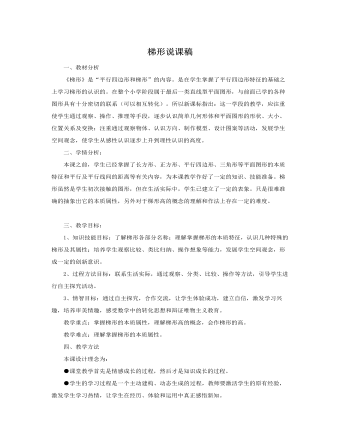
人教版新课标小学数学四年级上册梯形说课稿
1、找一找出示七巧板图,设疑:图中你能找出几个梯形?这个梯子最多能达到多高的高度?(见课件)2、拼一拼:①利用两个完全一样的梯形,拼出一种你熟悉的图形。②利用多种梯形图片,摆出一种最喜欢的图案。创设问题情境,深化思维层次,构建知识体系1、通过活动,培养学生创新意识和审美情趣,充分体现“玩中学,学中玩”的新课程理念。2、教会学生在活动中运用新知、拓展思维、加深认识,增强了学生的参与意识和主体意识。3、在拼摆中渗透转化思想,为梯形的面积推导作铺垫,构建新知学习的立体框架。五、交流评价,总结升华1、小结全课:谈谈你的收获及感想。2、集体评价:自评、互评自己在本课中的表现。完善知识结构,训练思维品质,升华发现能力①通过人性化语言,体现以人为本思想。②引入互动评价方法,交流活动感受,形成自我反馈机制。
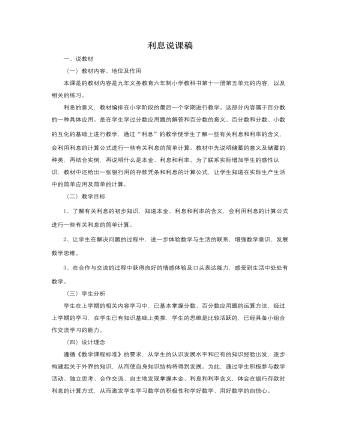
人教版新课标小学数学六年级上册利息说课稿
(二)合作交流,探究新知出示例题。(小黑板)先全班同学读题,教师在解释说明题目中“存定期一年”表示什么意思。一般来说,存款主要分为定期、活期等储蓄方式。所谓活期存款是指储户可以随时提取的一种方式;定期存款是有一定期限的一种存款方式,定期存款又分为整存整取和零存整取等形式。现在银行的定期存款有三个月、六个月、一年、二年、三年、五年的等等。(让学生在议一议、说一说的基础上,说出自己是怎样想的,交流归纳对问题的认识,理解存款的定期、活期的年月限即时间,以及存款方式。)小丽存的是“定期一年”,即小丽在银行存的100元在一般情况下要在银行存一年,如果有特殊情况也可以提前提取。下面请同学们合作交流,思考如下几个问题。(出示投影片。)(1)你猜一猜,小丽把100元存入银行叫做什么?(本金)(2)你估算一下,小丽把100元存入银行,定期一年,全部取出,取出的钱会大于100元吗?为什么?
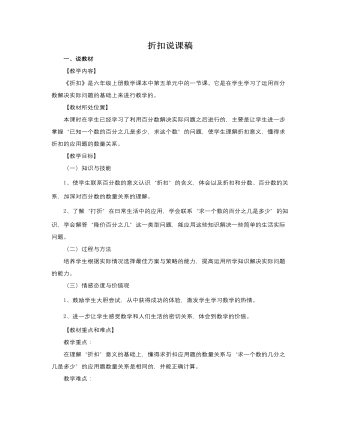
人教版新课标小学数学六年级上册折扣说课稿
(教师要深入各个小组中,参与学生方案的制定,但教师不是决策者,决策权在学生手中。)【设计意图:练习设计围绕本节课的教学目标,具有层次性。同时,开放性练习的设计——采用小组合作,让学生设计购书方案,使学生进一步感受到生活中处处有数学,运用数学知识还能省钱,合理安排日常生活开支,培养了学生自觉应用数学的意识。】五、课堂总结。同学们,通过这节课的学习,你有什么感想?你们今天的表现都很出色。其实生活中还有许多问题需要我们用数学知识去发现、去思考、去探索,希望大家能做个有心人!教学设计自我评析:新课程标准指出:“数学源于生活、寓于生活、用于生活。教师应重视从学生的生活经验和以有的知识中学习数学和理解数学。”
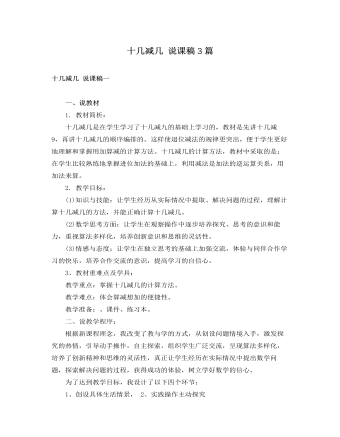
人教版新课标小学数学一年级下册十几减几 说课稿3篇
得到13-8=这个算式后,我让小朋友们想办法,“13-8怎么算?你是怎样想的?把你的想法告诉你小组的同学们。”由于我是用讲故事的形式引出这一问题的,因此在计算13-8时,小朋友们就被迫要自己想办法去计算,而不能光借助情境图去直接数出得数。这并不阻碍算法的多样化,相反更好地实现了算法多样化的目的,真正让学生成为了数学学习的主人。为了增加这堂课的趣味性,我有意将学生说出来的各种算法分别以他们的名字来命名,这样一来,学生兴趣盎然,都积极投入到了寻找算法的思考活动中来了。在寻求多样化的过程中,充分发挥了学生学习的主体性,培养了学生的创新精神,让每一个学生都能体验学习的成功。学生们在思考、讨论中可能会出现这样几种算法:
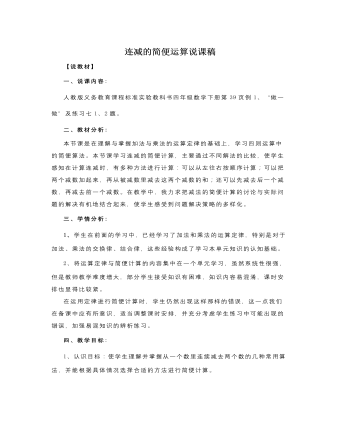
人教版新课标小学数学四年级下册连减的简便运算说课稿
在运用定律进行简便计算时,学生仍然出现这样那样的错误,这一点我们在备课中应有所意识,适当调整课时安排,并充分考虑学生练习中可能出现的错误,加强易混知识的辨析练习。 四、教学目标:1、认识目标:使学生理解并掌握从一个数里连续减去两个数的几种常用算法,并能根据具体情况选择合适的方法进行简便计算。2、能力目标:培养学生根据实际情况灵活选择算法进行计算的意识与能力,提高学生观察比较能力和思维的灵活性,发展学生思维。 3、情感态度价值观目标:通过学习活动,激发学生的学习兴趣,使学生感受到数学与现实生活的联系,学会用所学知识解决简单的实际问题。 五、教学重点: 理解并掌握从一个数里连续减去两个数的几种常用算法,并运用其进行一些简便计算。

人教版新课标小学数学一年级下册摆一摆,想一想 说课稿3篇
2,解决三个圆片能摆出的数。小精灵聪聪也给大家提问题了:(课件出示:你能用三个圆片表示不同的数吗?)你们回答他,能不能?(1)现在请小朋友们自己动手摆一摆,并且不自己摆出来的数写在老师发给你们的纸上,看谁摆的又快又对。(2)汇报结果:你摆了几个数?分别是什么?是怎么摆的 ?这个活动的设计是为了培养学生的动手操作能力,提高学生学习数学的热情。利用自己总结出来的方法来进行操作,让学生体会到成就感。通过学生的汇报,培养学生的语言表达能力,让学生的手,脑,口的能力同时得到了锻炼。3,小朋友们真棒,现在我们不摆圆片,你能不能在脑子里想着摆圆片的方法,在纸上写出四个圆片都能表示那些数字呢 ?这个活动的设计,是让学生从操作走向有序的思维,让学生有条理的思考问题,将数学抽象化。
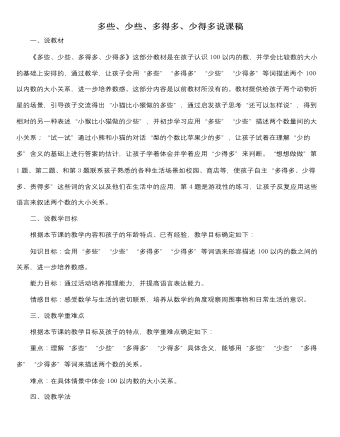
人教版新课标小学数学一年级下册多些、少些、多得多、少得多说课稿
在100以内数的范围里,18比50是少得多,但到了万以内数的范围内,可能只是少一些,所以结合具体情境帮助孩子体会是很重要的教学方法。想想做做第1题是小孩在进行拍皮球比赛,让孩子选合适的答案,在小组中说说是怎么想的,孩子在交流中就能体会到12比46少得多,50比46多一些,85比46多得多;想想做做第2题是发生在校园里的一个场景,让孩子自己选合适的答案,说说怎么想的,孩子就能体会到16比38少的多,36比38少一些,40比38多一些;第3题的场景是在商店里,让孩子先讨论、认识“贵多啦”的含义,在进行选择,在选择、辨析时进一步明白贵多啦就是“用的钱多得多”;最后,和孩子进行一些活动,比比身高(孩子和孩子比、老师和孩子比)、比比身边的一些数量大小,让孩子尝试用语言描述的同时体会数量之间的大小关系,感受到数学就在身边。最后由一个游戏结束本节课,让孩子拿一个数同45比一比,自己想两个数让同桌比一比,练习使用多些、少些多的多、少的多描述两个数量之间的大小关系,增强合作能力。

